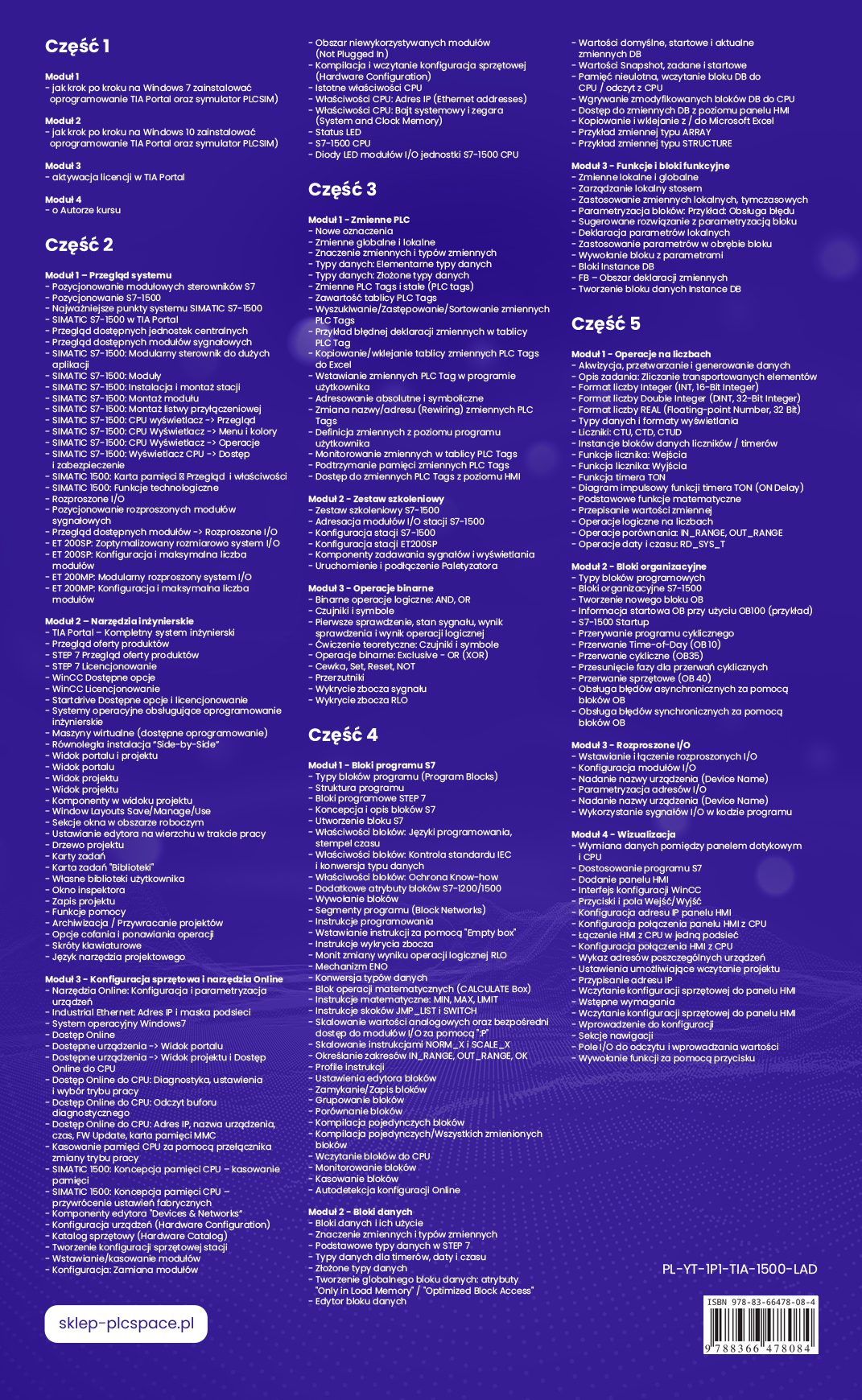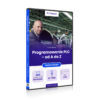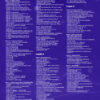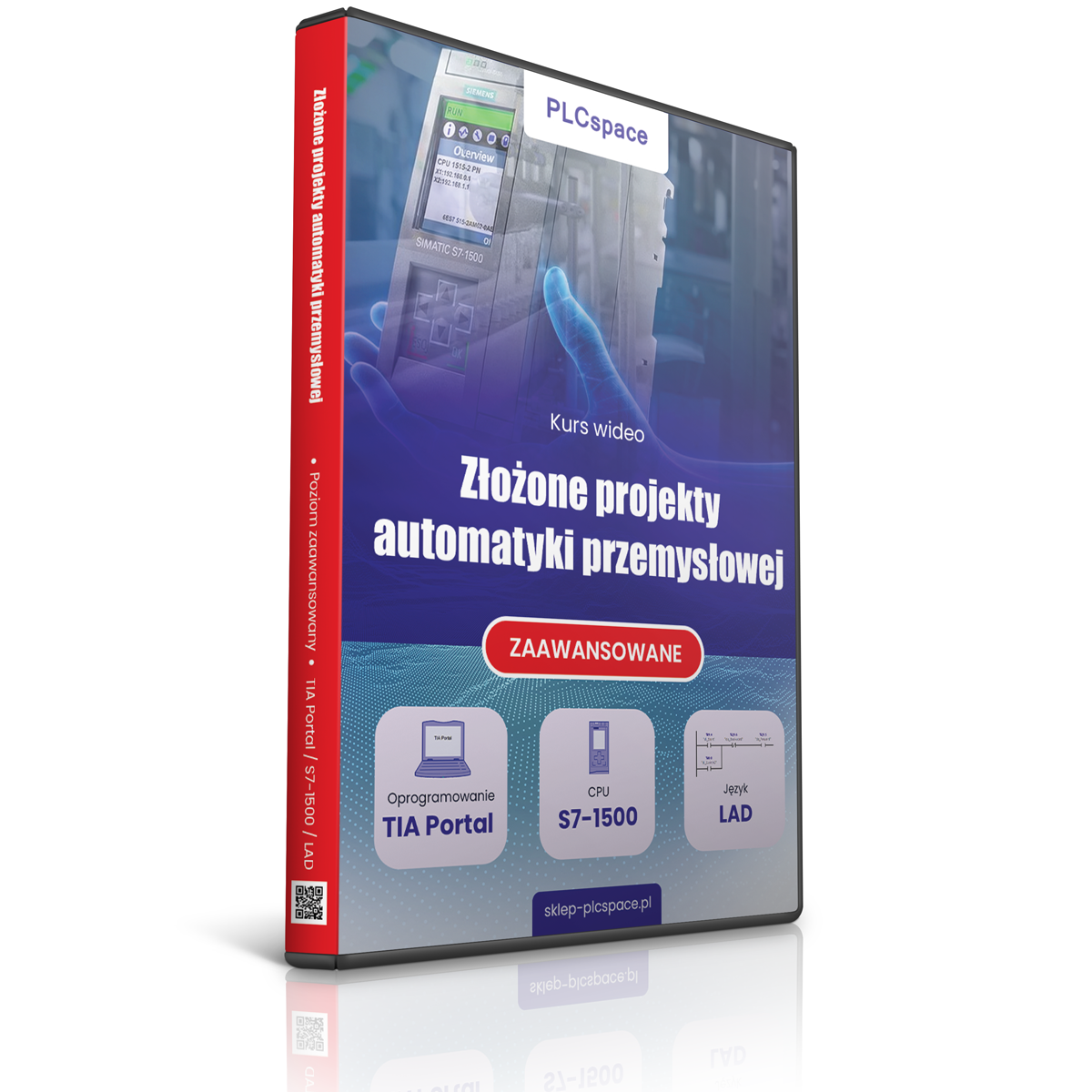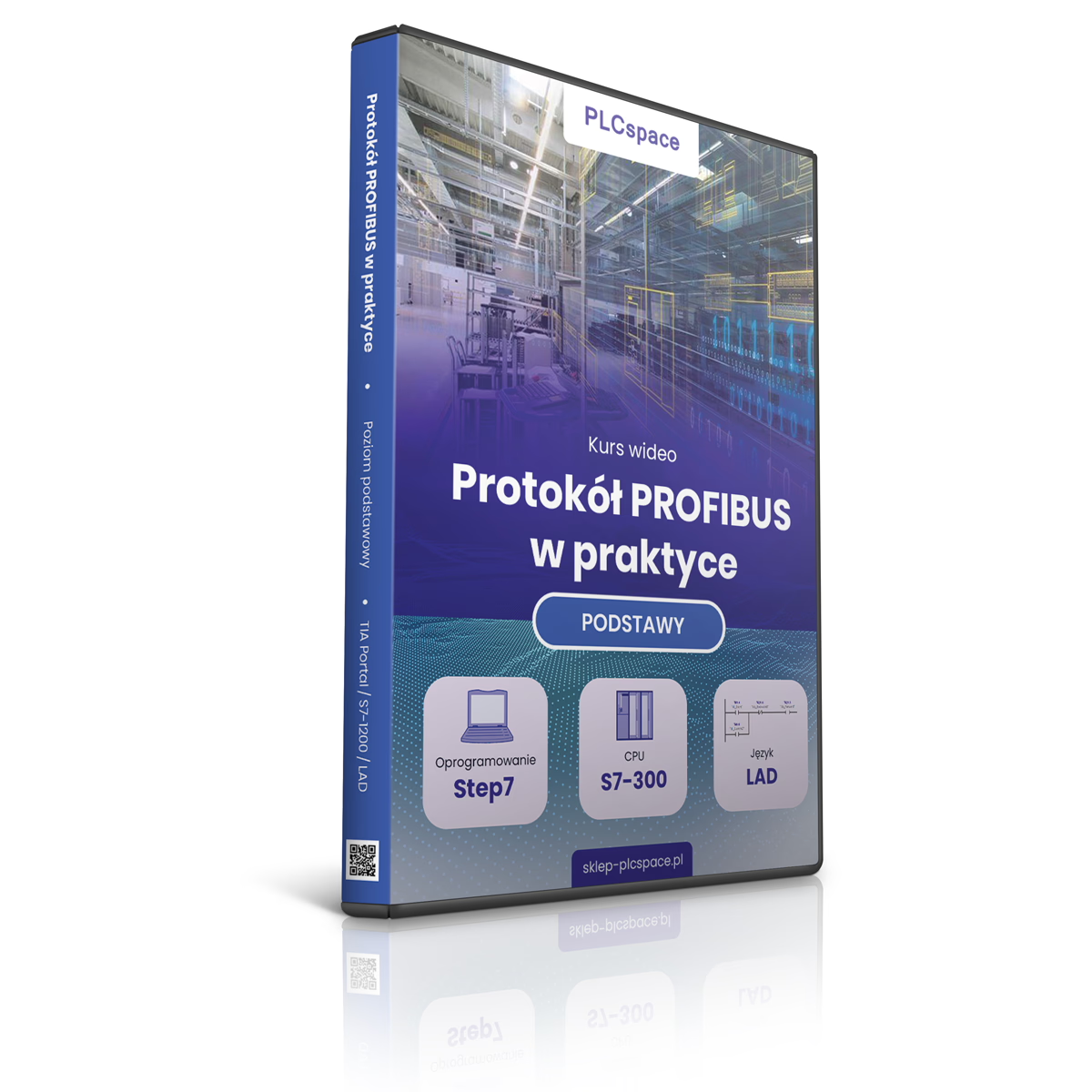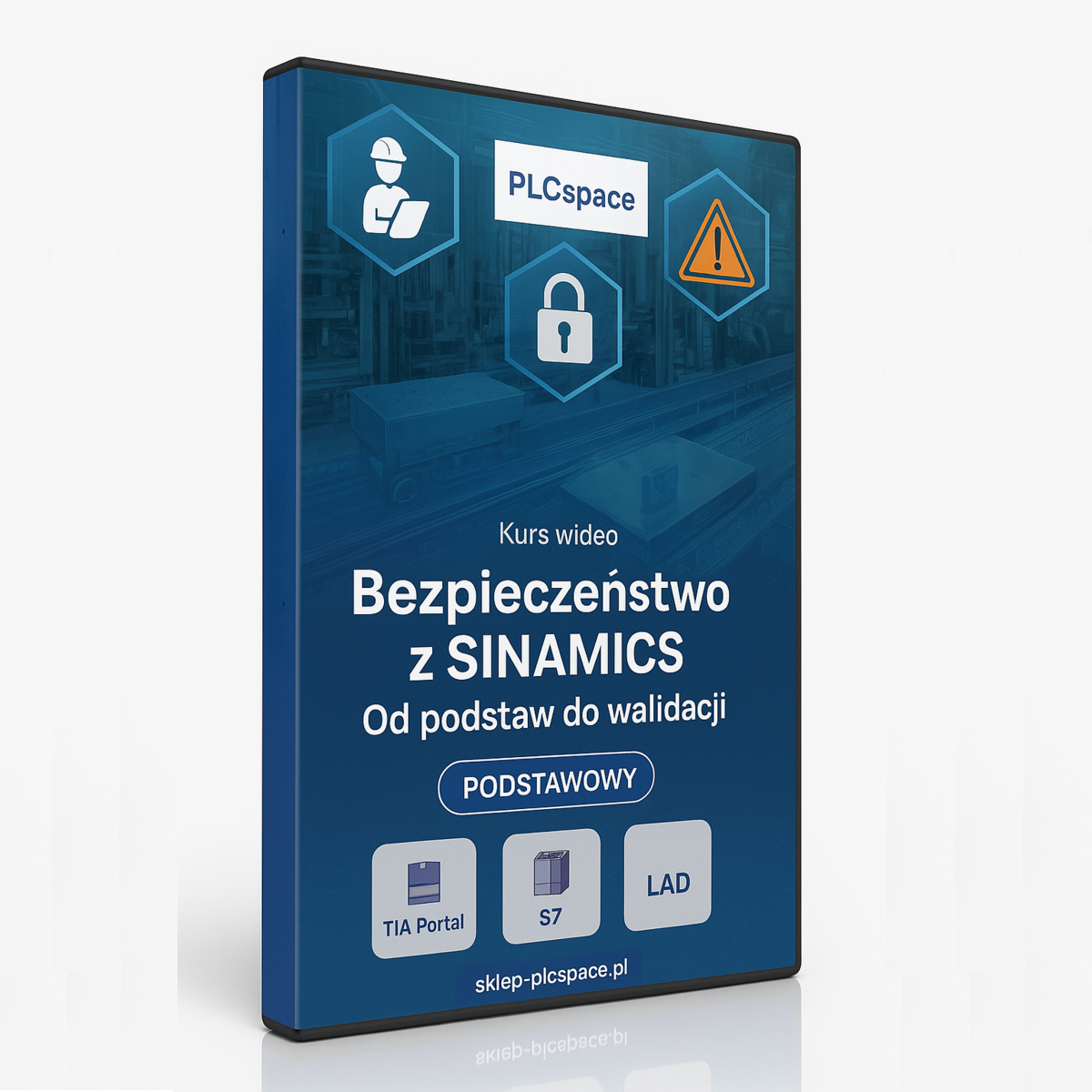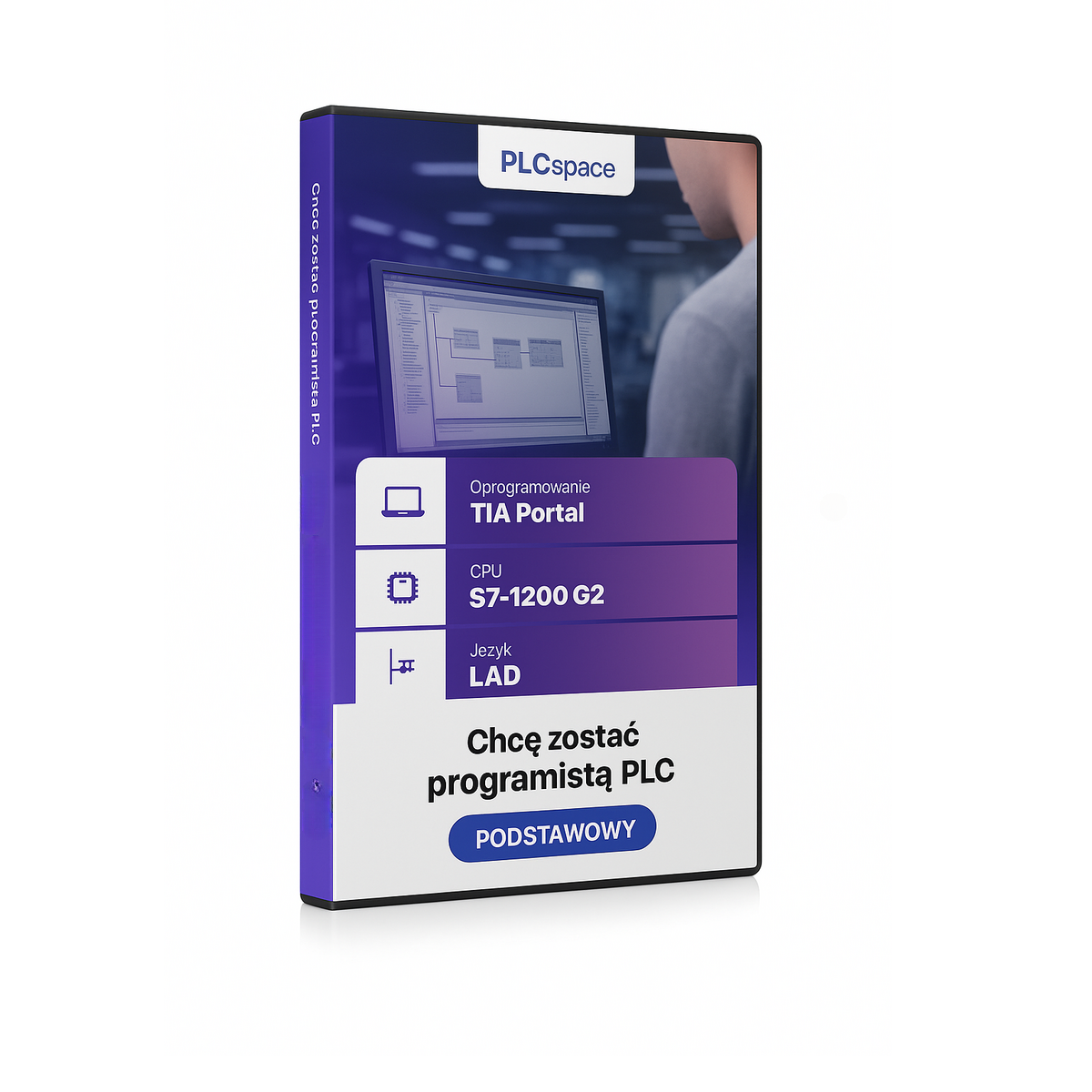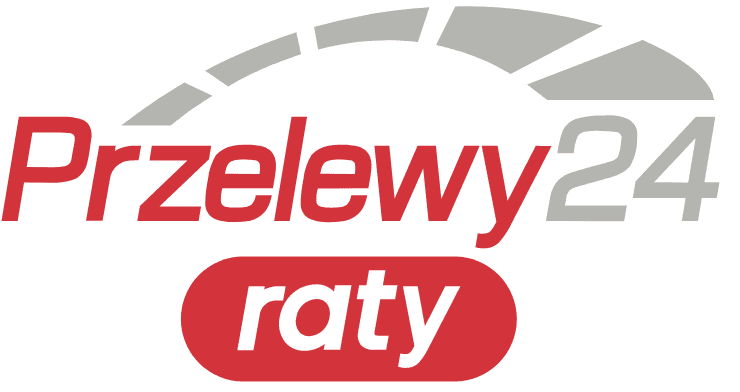PLC programming - from A to Z
- Level:
The development environment used in the course
- Software:
Core unit family used in the course
- CPU:
A set of rules that are used to develop programme code
- Language:
Frequency converter (inverter) family used in the course
- Drive
399.00 zł – 499.00 zł
What do you get when you enrol on a PLC programming course?
When you decide to attend your first PLC training course, you may be worried that you will be saddled with complicated knowledge, and in addition given in an indigestible way. Nothing could be further from the truth! This course is designed to familiarise you with the basics of PLC programming. You will receive carefully selected teaching aids:
PLC programming - from A to Z basic level. Siemens PLC programming course - TIA Portal software
One of the fastest controllers for automation - that's what your lecturers said about the Siemens Simatic S7-1500 PLC, right? Indeed, this CPU is distinguished by its extremely fast CPU response (less than 1 ns), but it also significantly increases the efficiency of the overall system thanks to its powerful bus and Profinet interface. The S7-1500 controller is the ideal choice for medium to complex projects where flexibility counts. It can be used in virtually any industry that relies on automation.
Our PLC course will allow you to master the basics of programming Siemens controllers, even if you have not dealt with them before. With us, you'll gain practical knowledge that you'll use in your work every day. If you have a technical background and dream of working as an automation technician, but don't know how to get started, you've come to the right place! After our Simatic PLC programming course, you will surprise your employer with your knowledge and out-of-the-box approach.
What is the Siemens Simatic PLC programming course about?
Our PLC programming course is designed to explain everything to you from the very beginning to intermediate level. The topics we cover during the course will be useful in any profession where you will come into contact with industrial programming. If you want to supervise work in a factory - knowing how to program Siemens Simatic PLCs will help you to better understand the relationships that occur between successive devices and you will learn how to design them safely.
This PLC training course focuses on Siemens' latest controller, the Simatic S7-1500, which, when combined with TIA Portal software, creates a highly efficient programming environment. Although the Siemens Simatic S7-1500 software is currently available in up to five languages, the training aims to introduce you to the graphical programming language LAD. It is popularly known as Ladder because it resembles an electrical circuit diagram.
The course is taught using the Palletizer app, where you will be able to practice the theoretical knowledge you have acquired. You will be shown how to create an efficient machine that will stack boxes and then push them back onto the pallet, making room for the next batch of goods.
Programming Siemens Simatic S7 controllers is convenient because it does not require you to purchase any additional software or hardware. You will solve all your problems in the TIA Portal v. 15.1 environment, which is just for controlling Siemens modules. You can download it for free from the manufacturer's website and the software will remain fully functional for 21 days. This is far more than you need to complete your PLC training.
You will find that you do not need to wade through thick books written in complicated language to learn how to program PLCs in LAD. Tired of learning the theoretical basics of PLCs after which nothing stays in your head? Here we go!
Knowledge test:
Is this course for you? Take this test MULTIPLE choice to check it out.
Egzamin Summary
0 of 10 Questions completed
Questions:
Information
You have already completed the egzamin before. Hence you can not start it again.
Egzamin is loading…
You must sign in or sign up to start the egzamin.
You must first complete the following:
Results
Results
0 of 10 Questions answered correctly
Your time:
Time has elapsed
You have reached 0 of 0 point(s), (0)
Earned Point(s): 0 of 0, (0)
0 Essay(s) Pending (Possible Point(s): 0)
Categories
- Not categorized 0%
- 1
- 2
- 3
- 4
- 5
- 6
- 7
- 8
- 9
- 10
- Current
- Review
- Answered
- Correct
- Incorrect
-
Question 1 of 10
1. Question
Can I0.0 and Q0.0 addresses be used simultaneously in the same SIMATIC S7-1500
CorrectIncorrect -
Question 2 of 10
2. Question
Is it possible to display the same variable multiple times in different numerical representations in the Watch table ?
CorrectIncorrect -
Question 3 of 10
3. Question
Can a program be uploaded to the PLC when it is in RUN mode ?
CorrectIncorrect -
Question 4 of 10
4. Question
What type of variables can be copied with the MOVE block
CorrectIncorrect -
Question 5 of 10
5. Question
What is the DEC instruction (block) used for ?
CorrectIncorrect -
Question 6 of 10
6. Question
What is the result of performing a CONV block operation on the number 2.7 if the result should be as type INT ?
CorrectIncorrect -
Question 7 of 10
7. Question
Can the CTU counter have a negative value?
CorrectIncorrect -
Question 8 of 10
8. Question
Can the FC1 function be called in the FC1 function code?
CorrectIncorrect -
Question 9 of 10
9. Question
Is it possible to stop the controller (switch to STOP mode) from the programmer (PC) ?
CorrectIncorrect -
Question 10 of 10
10. Question
What is the maximum number of time functions that can be used in a PLC?
CorrectIncorrect
Key information about the course
You will find that you are eager to reach for complementary knowledge yourself. On our course, we don't just teach the theoretical basics of programming. We show you concrete solutions, tricks and tricks that will make your work go more smoothly and faster, as well as safer for your colleagues. We teach you the analytical thinking that every PLC programmer should master.
Although the work of an automation programmer may be associated mainly with loneliness, in reality it is usually quite the opposite. PLC programmers become part of a team that works together on a single project. This means that you have to consult and discuss the results of your work with managers, logistics specialists, health and safety specialists on an ongoing basis. No worries! After our course, you will feel like a fish in water, programming PLCs for both small companies operating in a narrow specialisation and large manufacturing companies.
You will also learn how to avoid them and work on your workshop. Most PLC courses you find on the web are limited to imparting theory. However, we know that theory is far too little for beginners. We will show you how to avoid the pitfalls that lurk in your work as an industrial automation technician and explain why they can be dangerous.
The virtual factory will show you the typical challenges faced by automation professionals working in industry, you will master the stress before the real work. With Factory I/O, you will be able to test any solution that comes to mind before you propose it in practice. With Factory I/O, you will see the results of your work right away, and you will not just look at the source code.
With many years of working on large projects, we pass on the best programming practices that you will use in any job. You will meet many other programmers in your career and not all of them will represent a good school of programming. We want you to join the best in your field, so we will pass on not only knowledge and practice, but also thought patterns that will help you in your future work. It's not just about you being able to design software about PLC. It's about you doing it perfectly. We can help you do that.
Why choose our industrial automation course?
You will find more than one Simatic PLC tutorial on the market. What do you gain when you sign up for our basic course?
Sample lesson / What you will do after the course
What is the Simatic controller programming training in the TIA Portal environment?
The training consists of 5 parts, divided into individual modules on specific groups of issues. Once you have completed all of them, you will gain the ability to control PLC modules and use them in your daily work to improve the operation of your project. What examples of information will you find in each part?
Once you have completed all modules, you will have a working knowledge of machine controller programming that you can use in your everyday duties. Surprise your colleagues and see for yourself that PLCs can be easy to use.
-
Module 1
- how to install step by step on Windows 7
TIA Portal software and PLCSIM simulator)
- how to install step by step on Windows 7
-
Module 2
- how to install step by step on Windows 10
TIA Portal software and PLCSIM simulator)
- how to install step by step on Windows 10
-
Module 3
- licence activation in TIA Portal
-
Module 4
- about the course author
-
Module 1 - System overview
- Positioning of S7 modular controllers
- Positioning of the S7-1500
- Highlights of the SIMATIC S7-1500 system
- SIMATIC S7-1500 in TIA Portal
- Overview of available central units
- Overview of available signal modules
- SIMATIC S7-1500: the modular controller for large
applications - SIMATIC S7-1500: Modules
- SIMATIC S7-1500: Installation and assembly of stations
- SIMATIC S7-1500: Module assembly
- SIMATIC S7-1500: Installation of the terminal block
- SIMATIC S7-1500: CPU display -> Overview
- SIMATIC S7-1500: CPU Display -> Menus and colours
- SIMATIC S7-1500: CPU Display -> Operations
- SIMATIC S7-1500: CPU display -> Access
and security - SIMATIC 1500: Memory card → Overview and properties
- SIMATIC 1500: Technological features
- Distributed I/O
- Positioning of distributed modules
signal - Overview of available modules -> Distributed I/O
- ET 200SP: Size-optimised I/O system
- ET 200SP: Configuration and maximum number
modules - ET 200MP: Modular distributed I/O system
- ET 200MP: Configuration and maximum number
modules
-
Module 2 - Engineering tools
- TIA Portal - The complete engineering system
- Overview of the product range
- STEP 7 Overview of the product range
- STEP 7 Licensing
- WinCC Available options
- WinCC Licensing
- Startdrive Available options and licensing
- Software operating systems
engineering - Virtual machines (software available)
- Parallel "Side-by-Side" installation
- Portal and design view
- View of the portal
- View of the project
- View of the project
- Components in the project view
- Window Layouts Save/Manage/Use
- Window sections in the work area
- Putting the editor on top while working
- Project tree
- Task sheets
- Library task sheet
- User's own libraries
- Inspector's window
- Project record
- Assistance functions
- Archiving / restoring projects
- Undo and redo options
- Keyboard shortcuts
- Design tool language
-
Module 3 - Hardware configuration and online tools
- Online tools: Configuration and parameterisation
equipment - Industrial Ethernet: IP address and subnet mask
- Windows7 operating system
- Online access
- Available devices -> Portal view
- Available devices -> Project view and Access
Online to CPU - Online access to the CPU: Diagnostics, settings
and operating mode selection - Online access to the CPU: Reading buffer
diagnostic - Online access to the CPU: IP address, device name,
time, FW Update, MMC memory card - CPU memory deletion with switch
changes in operating mode - SIMATIC 1500: CPU memory concept - erasure
memories - SIMATIC 1500: CPU memory concept -
restore factory settings - Components of the "Devices & Networks" editor
- Hardware configuration
- Hardware Catalog
- Creation of station hardware configuration
- Insertion/deletion of modules
- Configuration: swapping modules
- Area of unused modules
(Not Plugged In) - Compilation and loading of the hardware configuration
(Hardware Configuration) - Essential characteristics of the CPU
- CPU properties: IP address (Ethernet addresses)
- CPU properties: System and clock byte
(System and Clock Memory) - Status LED
- S7-1500 CPU
- LEDs of the I/O modules of the S7-1500 CPU
- Online tools: Configuration and parameterisation
-
Module 1 - PLC variables
- New designations
- Global and local variables
- Meaning of variables and variable types
- Data types: Elementary data types
- Data types: Complex data types
- PLC Tags and constants
- Content of the PLC Tags board
- Searching/replacing/sorting variables
PLC Tags - Example of incorrect declaration of variables in an array
PLC Tag - Copy/paste PLC Tags variable table
to Excel - Inserting PLC Tag variables in the program
user - Absolute and symbolic addressing
- Renaming/addressing (Rewiring) of PLC variables
Tags - Definition of variables from the program level
user - Monitoring of variables in the PLC Tags table
- PLC Tags variable memory support
- Access to PLC Tags from the HMI level
-
Module 2 - Training kit
- S7-1500 training set
- Addressing of I/O modules of the S7-1500 station
- Station configuration S7-1500
- ET200SP station configuration
- Signal and display components
- Commissioning and connecting the palletiser
-
Module 3 - Binary operations
- Binary logical operations: AND, OR
- Sensors and symbols
- First check, signal status, result
checks and the result of a logical operation - Theoretical exercise: Sensors and symbols
- Binary operations: Exclusive - OR (XOR)
- Solenoid, Set, Reset, NOT
- Transfer switches
- Edge detection
- Detection of the RLO slope
-
Module 1 - S7 programme blocks
- Program block types
- Programme structure
- STEP 7 programme blocks
- Concept and description of S7 blocks
- Creation of block S7
- Properties of blocks: Programming languages,
time stamp - Features of the blocks: IEC standard control
and data type conversion - Properties of the blocks: Protection of know-how
- Additional attributes of S7-1200/1500 blocks
- Calling the blocks
- Programme segments (Block Networks)
- Programming instructions
- Inserting instructions using the "Empty box"
- Slope detection instructions
- Monitored change in result of RLO logic operation
- ENO mechanism
- Conversion of data types
- CALCULATE Box
- Mathematical instructions: MIN, MAX, LIMIT
- JMP_LIST and SWITCH jump instructions
- Analogue value scaling and direct
access to I/O modules via ":P" - Scaling with NORM_X and SCALE_X instructions
- Determination of IN_RANGE, OUT_RANGE, OK ranges
- Instruction profiles
- Block editor settings
- Block closing/saving
- Grouping of blocks
- Block comparison
- Compilation of individual blocks
- Compilation of single/all modified
blocks - Reading blocks into the CPU
- Block monitoring
- Block erasure
- Online auto-detection of configuration
-
Module 2 - Data blocks
- Data blocks and their use
- Meaning of variables and variable types
- Basic data types in STEP 7
- Data types for timers, date and time
- Complex data types
- Creating a global data block: attributes
"Only in Load Memory" / "Optimised Block Access". - Data block editor
- Default, starting and current values
DB variables - Snapshot, target and start values
- Non-volatile memory, loading of a DB block into the
CPU / CPU readout - Uploading modified DB blocks to the CPU
- Access to DB variables from the HMI
- Copy and paste from/to Microsoft Excel
- Example of an ARRAY-type variable
- Example of a variable of type STRUCTURE
-
Module 3 - Functions and Function Blocks
- Local and global variables
- Local stack management
- Use of local, temporary variables
- Parameterisation of blocks: Example: Error handling
- Suggested solution with block parameterisation
- Declaration of local parameters
- Use of parameters within a block
- Calling a block with parameters
- Instance DB blocks
- FB - Variable declaration area
- Creation of a DB Instance data block
-
Module 1 - Operations with figures
- Data acquisition, processing and generation
- Job description: Counting of transported items
- Integer number format (INT, 16-Bit Integer)
- Double Integer (DINT, 32-Bit Integer) number format
- REAL number format (Floating-point number, 32 Bit)
- Data types and display formats
- Counters: CTU, CTD, CTUD
- Data block instances of counters/timers
- Counter functions: Inputs
- Counter function: Outputs
- TON timer function
- Pulse diagram of the TON (ON Delay) timer function
- Basic mathematical functions
- Transcription of the variable value
- Logical operations on numbers
- Comparison operations: IN_RANGE, OUT_RANGE
- Date and time operations: RD_SYS_T
-
Module 2 - Organisational blocks
- Types of programme blocks
- Organisation blocks S7-1500
- Creating a new OB block
- OB starting information using OB100 (example)
- S7-1500 Startup
- Interruption of a cyclic programme
- Time-of-Day Interruption (OB 10)
- Cyclic interruption (OB35)
- Phase shift for cyclic interrupts
- Hardware interruption (OB 40)
- Asynchronous error handling with
OB blocks - Handling synchronous errors with
OB blocks
-
Module 3 - Distributed I/O
- Insertion and connection of distributed I/O
- Configuration of I/O modules
- Device Name
- Parameterisation of I/O addresses
- Device Name
- Use of I/O signals in program code
-
Module 4 - Visualisation
- Data exchange between touch panels
i CPU - Adaptation of the S7 programme
- Addition of HMI
- WinCC configuration interface
- Buttons and input/output fields
- Configuring the IP address of the HMI
- Configuring the connection between the HMI and the CPU
- Combining the HMI and CPU into a single subnetwork
- Configuration of the HMI connection to the CPU
- List of addresses of individual devices
- Settings for loading the project
- IP address assignment
- Uploading the hardware configuration to the HMI
- Initial requirements
- Uploading the hardware configuration to the HMI
- Introduction to configuration
- Navigation sections
- I/O field for reading and entering values
- Calling a function using the button
- Data exchange between touch panels
Software and hardware used
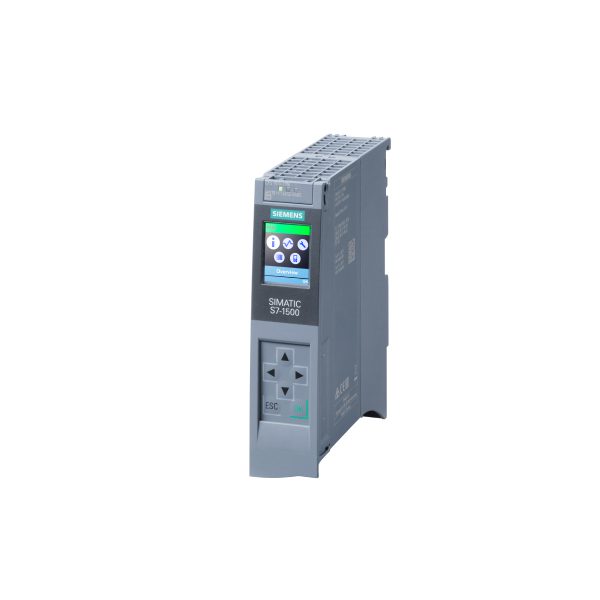
CPU S7-1500
They are available in the classic and et200sp housing. The SIMATIC S7-1500 is a modular automation system with medium and higher performance. Different controller versions allow you to match the corresponding application. Depending on requirements, the programmable controller can be expanded with input/output modules for digital and analogue signals, as well as technology and communication modules.
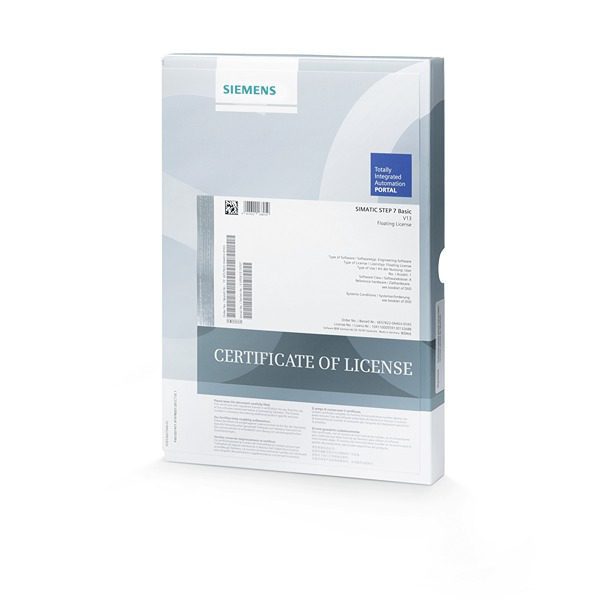
TIA Portal software
Totally integrated automation is a development environment that combines PLC (programming), HMI(visualisation) and startdrive(drive technology).
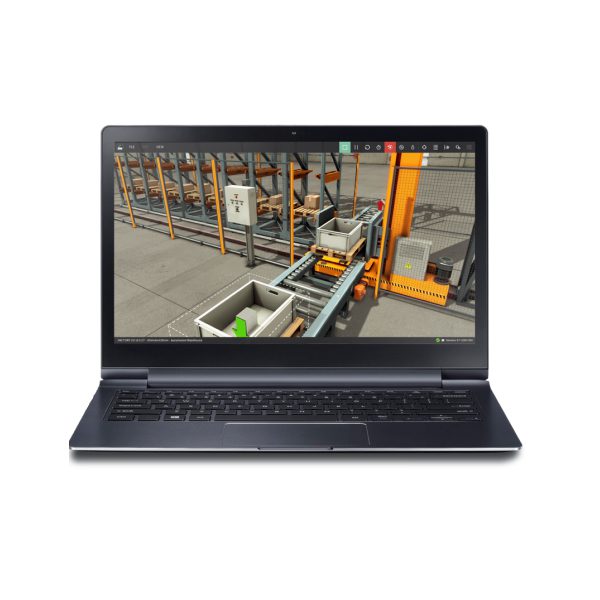
Factory IO
Typical machine scenarios can be run in Factory IO, and the virtual factory connects to the SIM PLC simulator (or the actual PLC. Programming of the controller is possible in the programming environment (depending on the PLC family), and insight into its operation is available during the online connection
What will you be able to do after completing the course?
It's not easy to get a degree at a technical school - is the effort put in worth it? The good news: it definitely is. The ability to program PLCs is a useful and sought-after qualification, providing you with a rare freedom to choose your specialisation. Here are some suggestions:
In the current education system, it is a veritable plague to waste time discussing theoretical issues unsupported by knowledge of practical applications - and it is the latter that employers are looking for. Thanks to our training, even someone with no previous programming experience will learn practical solutions that will help them find their way in the job market.


Guarantee
and certificate
If, after 14 days of purchase, you find that it is not for you, I will refund 100% of the course price. Upon completion of the course, you will receive a certificate in two languages - Polish and English.

Frequently asked questions
-
Will I receive a confirmation after my purchase?
Yes, you receive an email. Sometimes emails end up in SPAM or other folders. Please check your mailbox carefully.
-
Is there a difference between the media on which the course can be ordered?
No. The material is the same regardless of the type of storage medium. At the time of purchase, you decide which type of data carrier you choose, i.e. online, DVD or USB.
-
Which PLC programming language should I choose when starting out?
If you are an electrician then LAD. If there has been any exposure to text-based languages (C, C++, C#, Java, etc) then SCL. If there has been no exposure to any programming at all then the basic course is LAD and SCL (the solution to each task is shown in two languages).
-
Is this course for me if I have never used a PLC?
Yes. The basic courses are just set up so that people with no exposure to Siemens PLCs can learn such skills. The student is guided step by step (as can also be seen in the course table of contents).
-
What tools are used for consultation?
Consultations take place via Skype or TeamViever.
-
How do I make an appointment for a consultation?
Please send an email to biuro@plcspace.pl with your questions (problems) and suggestions for a convenient date for your consultation (via Skype or Teamviever).
-
How long are the consultations valid?
This is 60 calendar days from the date of purchase.
-
Can I deliver the course on different computers?
Yes. The course material (videos) can be viewed on any computer.
-
What does the online version of the course look like?
You receive the course by email, where there are private links to the videos.
-
What if a problem arises during the course?
Please email me with a description of the problem at: biuro@plcspace.pl.
-
What is the access time for the course?
No time limits for any medium (i.e. online, DVD or USB version).
-
Do I need to have any experience with programming?
No. The basic course gives step-by-step all the information needed from 'scratch'.
-
Will I need to purchase a licence for the Factory IO software?
No. There is information in the course on how to obtain licences to complete the material.
-
Will I need to purchase a licence for the PLC development environment?
No. There is information in the course on how to obtain licences to complete the material.
-
Is it possible to return the course?
Yes.
-
Will I need a PLC to deliver the course?
No. A real controller is not necessary. The course is designed in such a way that it can also be completed on a virtual controller. It all depends on what the trainee has at their disposal.
-
How do I buy a course?
Just click Add to basket and complete the form and make payment.
-
When does the course start?
-> Online version - immediately after payment
-> Physical version - when you receive the package from the carrier.
Buy as a set and save
Select at least 2 courses from the list and the first free book item (three selections in total) and an automatic discount of 25% will be calculated in your basket.
If you want to find out more about a particular course, click on its name and the page will take you to its offerings.
Companies that have benefited from our courses




































Feedback from students
 Stanislaw
Stanislaw
What sets this course apart is the opportunity to acquire practical, concrete knowledge. Everything is clearly explained. Definitely recommended!
 Marcel
Marcel
After going through the course, I know what the components of the programming environment are and what to do step by step. Now I feel confident and know what I am doing
 Leon
Leon
Course delivered in a very accessible way. Contains a lot of interesting and useful information.
 Michael
Michael
I can honestly recommend the course. It is solid and factual knowledge. I will definitely be buying more.
 Victor
Victor
Thanks to the course, I have decided to go further in this direction. The goal is to look for a more challenging and better job
 Peter
Peter
The course prepared by Mr Tomasz is distinguished by its high level of content and meticulously prepared lessons. They are planned in a clear and sensible manner, making it easier to assimilate knowledge and return to the material if necessary. An additional advantage is the possibility of a free consultation.
 Nikodem
Nikodem
Definitely recommended! The facts themselves, no unnecessary dwelling on issues.
 Ignatius
Ignatius
This is my first course, certainly not my last. I am impressed with the substantive quality of the knowledge.
 Tymon
Tymon
Everything clearly explained, you can really learn a lot. Lots of practical information and examples to help you remember everything. In my opinion, it is worth using this form of learning because you can learn anytime and anywhere. It is practical and convenient.
You may also be interested in:
- Level:
The development environment used in the course
- Software:
Core unit family used in the course
- CPU:
A set of rules that are used to develop programme code
- Language:
Frequency converter (inverter) family used in the course
- Drive
1.199.00 zł
- Level:
The development environment used in the course
- Software:
Core unit family used in the course
- CPU:
A set of rules that are used to develop programme code
- Language:
Frequency converter (inverter) family used in the course
- Drive
999.00 zł
- Level:
The development environment used in the course
- Software:
Core unit family used in the course
- CPU:
A set of rules that are used to develop programme code
- Language:
Frequency converter (inverter) family used in the course
- Drive
999.00 zł
- Level:
The development environment used in the course
- Software:
Core unit family used in the course
- CPU:
A set of rules that are used to develop programme code
- Language:
Frequency converter (inverter) family used in the course
- Drive
1.199.00 zł

